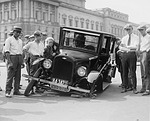Good questions have been asked. The answers only appear elusive while in reality the answers to “education reform” have been overlooked, forgotten, ignored, and/or buried. And oh so many aspects of reform are misunderstood.
Prompted by Thoughts From a Former KIPP Teacher: Testing, Common Core, and Charters are Myths, I now firmly believe we have got to have a “come-to-Jesus” talk about the standardization movement!
First, is there a need to improve some schools? Yes, the inequality issue is to die for and least we forget, some have! I think we all know that the “gap” between rich and poor & minority is real – common ground that should be a common cause.
So, here is what pulled my trigger today — a misunderstood word —EXPECTATIONS. I tried to at least partially clarify the concept in a short blog many months ago. (Please read)
Today, I shot forward in this article to read something much more disturbing.
“…focusing on standards as one of many means to bolster achievement in high poverty/high minority schools is a way to strive for equity. Unfortunately, as Diane Ravitch has accurately pointed out, the implementation of the standardization movement over the last 20 years has fallen short.”
Implementation fell short? Yes, but that is not the bigger thing wrong here.
Whoa to standards-based “reforms”!
Overlooked, forgotten, or ignored are the Effective Schools Correlates which seems strange to me given that I very firmly believe the philosophy behind the 1965 Elementary and Secondary Education Act is based on the REAL community education concept which produced the “effective schools” studied by Ronald Edmonds and others.
Why has it gotten forgotten?
The Modern Community Education Movement was shoved to the side of the road and almost completely buried by the Standards Movement that rose to the occasion when the “crisis” in education caught the public’s attention in the 80’s and that movement rolled on unchecked and not questioned enough…even today.
We need to talk about what standards can and can’t do in depth but for the time being, consider this; * effective schools had variable standards*. “Standards” themselves were not the key factor in the high-poverty/high-minority/high-performing schools that were dubbed “effective.” THE standards never deserved THE “focus.”
Why haven’t we talked about all this sooner?
“We can’t. We’ve got internal political problems.”
If we had taken more time to analyze data as the Sandia Research Laboratory engineers did in the 90’s, we probably would have put the brakes on and questioned our focus on standards and testing. It might have occurred to us to discuss what we were doing right to produce the National Assessment of Educational Progress math scores that “had been steady for whites and rising for blacks and Hispanics.”
Talk about buried. I called Sandia Laboratories long ago searching for the Sandia Report. I asked them to put the report up on the Internet. I had a nice chat with a young man and we laughed over the fact that surely with the technology, and engineers at Sandia, they could scan the report and get it online. They never got back with me. Instead, I found a summary on micro phish at a private college library and spent some time copying the 50 page summary page by page.
I appreciate the view of the KIPP teacher that wrote the blog about testing, Common Core, equality and the acknowledgement made that No Child Left Behind-like “reforms” drive the focus to test scores. I’m sure for most people it didn’t open a can of worms like it did for me. It is so important, if you want the right answers to lead us forward, that we understand the history of American education. The history is convoluted but the truth, in my humble opinion, is more politically powerful than the politics of reform IF the truth gets a full and honest hearing.
I want to hear what others see as the truth starting with President Obama and Secretary of Education Duncan. How do we make THAT happen?
As John F. Kennedy said at the 1963 Commencement at American University,
“Our problems are manmade; therefore, they can be solved by man.”….or woman!



